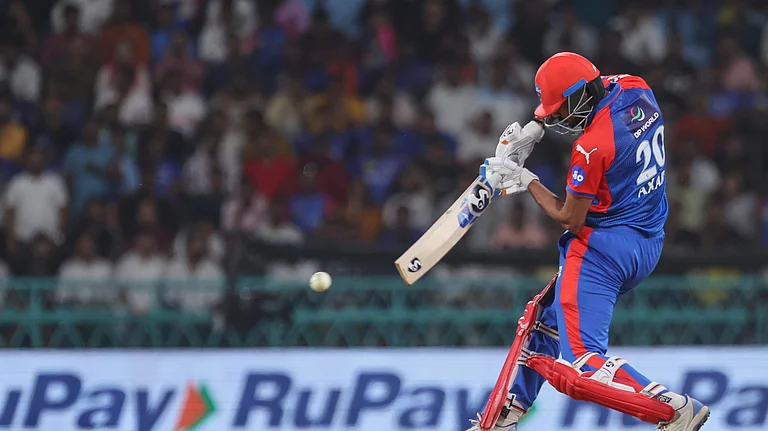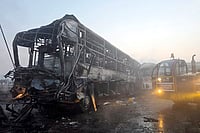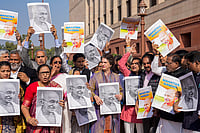THREE months ago, five men of the remote villages of Panchrole and Benadubi in Midnapore district went to Contai, a few hours away, in search of work as daily labourers . They never returned home. On the night of July 30-31, Sona Pahari (20), Alok Mallik (21), Balai Mallik (30), Sanjay Singh (25) and Tapan Mallik (25), were lynched by a mob—they had been mistaken for dacoits.
It was left to Khanta Mallik, widow of Balai, to bring home his blood-splattered body. What’s more, the administration had not even bothered to inform her of the tragedy. She learnt of her husband’s death from neighbours who happened to hear the news on the radio. "The news was that five men had been killed and their identity had not been established. As neighbours advised us, we collected some money and left for Contai because five men from our villages had gone there in search of work. The police showed us five bodies covered with blood. We identified our men by the clothes they wore," were Khanta’s stoic words.
Mob killings are on the rise in . So far this year, 79 people have been killed in mob violence, making it an open season for rabble-rousers and anti-socials. The toll, comprising suspected criminals, child-lifters or "witches", is the highest in the country. But this does not seem to have embarrassed either the administration or a political leadership that preens itself on its political awareness—there have already been several anti-US demonstrations in the wake of developments in West Asia.
Except for cursory condemnations of such incidents, no senior political leader or administrator has bothered to arrest the shameful slide into barbaric anarchy. According to sources, out of 40 instances of mob violence reported, authorities have initiated action in only five.
As for the Midnapore incident, all the five lynched were from the Lodha tribe—and thereby hangs a tale.
It dates back to the colonial British, who in a bid to quell trouble in rebellious Midnapore district, declared the hapless tribespeople as criminals. The stigma stuck. And now it has become habitual for administrative functionaries and other people in the district to conclude that if there is a theft or dacoity anywhere, the Lodhas must be responsible.
The Lodhas are beyond the pale as far as other tribes like the Santhals, themselves oppressed, are concerned. A separate Jharkhand state will hardly change anything for them because the Santhals, too, look down on them. True, after 1947, some land in the district has been doled out to the Lodhas, in Jhargram and elsewhere. But little cultivation is possible in the arid tracts. During hard times, the Lodhas forage for roots and berries,or face starvation. Some indulge in petty crimes. And pay for it with their lives.
The question naturally arises: why were the five men killed? Well, it was primarily because the local residents took the law in their own hands. According to one version, the villagers were watching a video show when they heard some noise. An emissary reported that 10-15 men had come in a trekker and were creating trouble in front of two houses. Without bothering to check it out, the villagers chased the men. While some fled, five of them jumped into a pond. But they were fished out and lynched—it was 12.30 am. The police accepted this version.
Later, doubts began to arise. For a start, there were murmurs that the violent chain of events had occurred by 10 pm. Second, no telltale trekker could be found, even hours after the killings. Khanta and Gour Singh, Sanjay’s brother, were categorical that the five men had not gone to Contai on a trekker: "Where would they find that kind of money?" they asked.
The police arrested seven persons connected with the killings, but this led to a protest bandh in Contai. No political party followed up the matter. Again, the fact that they were Lodhas went against them.
Till last week, Khanta and Gour—they both suffer from tuberculosis—and the other families, had not received a morsel of official assistance, although their local legislator is the minister for water resources, Nandagopal Bhattacharya. No police officer or political leader visited the villages. According to the local panchayat member, Adhar Singh, who is a Lodha too, efforts to secure help for the affected families hadn’t been effective. The widow of one of the victims tried to meet the SP but he was busy in meetings whenever she went to his office.
In recent times, there have been some other instances of such cold-blooded killings in Midnapore alone. Some time ago, at Mahisadal thana, a youth, Chandu Das, was killed in police custody, although this was officially denied. Das had been brought to the thana along with a friend by some friends who were upset with them and wanted to get even. Later, the police said that both had been beaten up by the local people and Chandu had been brought dead. His friend, Biswajati Adhikary, gave a different version. It all started over the demand for something as innocuous as puja subscriptions. "But the police gave them the beating of a lifetime. I do not know what they did with Chandu, who was taken to hospital and then brought back to the thana and again taken to hospital, this time dead," said a local newsman.
It is not as though the increasing lumpenisation of life in parts of rural Bengal has escaped the notice of observers. A social scientist attached to Calcutta University points out that organised violence has been a recurrent theme in Bengal’s political behaviour. What is happening today may only represent a return to a violent phase in , according to this view.
Says A.B. Choudhury, former DIG of police who has specialised in tribal customs and culture, and crime patterns: "There is little doubt that the level of violence in our society is increasing if the series of mob lynchings is any indication. It is not new. Back in the ’40s we had this phenomenon when suspected childlifters were often killed."
As for the ruling Leftists, they are spouting the usual statements to condemn the act without delving into the causes. According to Anil Biswas, member, CPI(M) Central committee, "this business of mobs taking the law into their own hands is the work of anti-socials. We admit that it has increased. We have already begun local awareness classes. We will definitely bring these lynch mobs under control."
A Congress leader, however, pointed out that it was time the state administration did something to stem the trouble. "Regardless of all the talk of discipline emanating from the Left leadership, facts speak otherwise." He narrates an incident which only shows the extent of the rot: the SP of Murshidabad district was slapped in public by anti-socials when he tried to interfere with the roughhewn justice provided by a kangaroo court. And as the government turned a blind eye, the panchayat leader ordered him to leave the area, which he had to. The message is simple—lumpens and para dadas (local toughs) are in control.






















